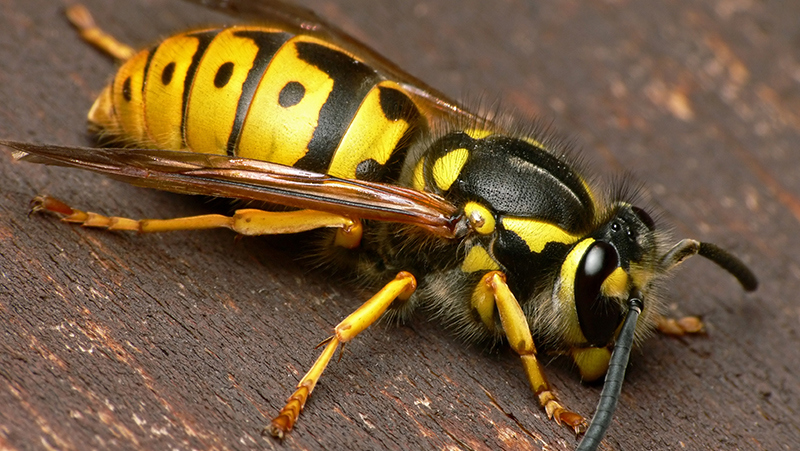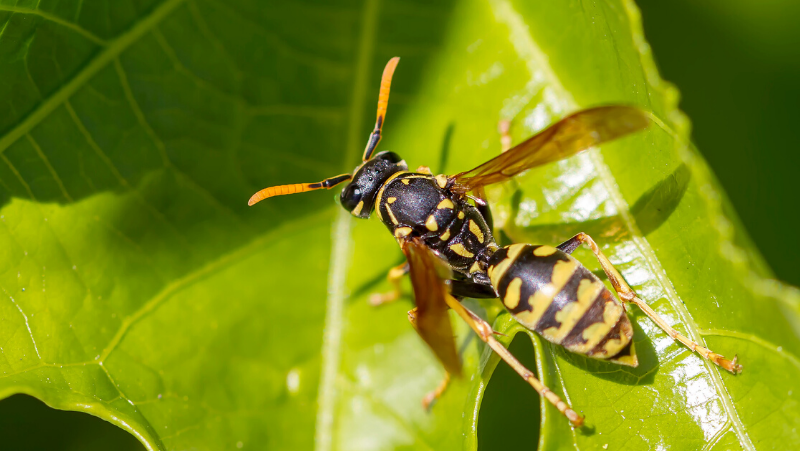Yates Account
Join now
Create a Yates account today!
Sign up to join the Yates Garden Club for monthly e-mails packed with seasonal inspiration, tips for success & exclusive promotions.
Plus if you’re a Garden Club member you can take part in the Yates Growing Community - a blog to share successes, get advice & win prizes in fun challenges along the way!

Forgot password
Enter the email address associated with your account, and we'll email you a new password.
Hymenoptera

German Wasp (Vespula germanica)
What are Wasps?
New Zealand has a relatively small number of native wasp species; usually black or dark-coloured, they're solitary and hunt insects for food. Although they sting when provoked, they aren't known to cause any problems to the environment. Unfortunately, there are also four accidentally-introduced pest wasp species that are seriously destructive, and detrimental to the areas they invade.
Introduced wasps are known to kill and eat an enormous volume of insects every year, so they've evolved into a serious threat to native ecosystems wherever they have established themselves. Wasps aren't just a problem for their prey insects; they hog the insects and honeydew that native birds, skinks and geckos need to survive. Wasps are devastating to Monarch butterflies: their caterpillars are a tempting source of “protein” that wasps use to feed their young, so it's good to protect them by eliminating wasp nests.
There are two ground-nesting species that are the main offenders in harming ecosystems. These are German Wasps (Vespula germanica) and Common Wasps (Vespula vulgaris). These social wasps are very aggressive species and can be quite dangerous when their numbers get high. Worker wasps are 12–15mm long (queens and males are 20mm long, but it's very rare that you'll see them).
Both Vespula species look similar, being very bright yellow and black, with their abdomen lined with yellow and black banding with distinct black triangular markings at the top of each band. They have a pair of black antennae, 3 pairs of yellow legs and 2 pairs of transparent wings on their back. There is a visible difference: German wasps have separate black dots in between the black rings on the abdomen. Common wasps have black dots merged into the black rings, they aren't separate.
The other two problematic species are Asian Paper Wasps (Polistes chinensis) (see image below) and Australian Paper Wasps (Polistes humilis humilis). They aren't as troublesome as the Vespula wasps above, but they're just as annoying around your house and outdoor areas! Paper wasps hang their small nests from branches or buildings (they prefer nesting under overhangs or eaves).
Paper wasps are generally about 10–15mm in length and longer and narrower-looking than Vespula wasps; they're also noticeably less aggressive. Asian Paper Wasps have yellow antennae, with less yellow banding and more prominent black banding than Vespula wasps.
Wasps defend their nest aggressively, swarming out to attack if disturbed. Unlike bees that die after only one sting, wasps can repeatedly sting and remain unaffected. Their sting is painful and causes inflammation. Multiple stings, or a sting to the throat, can be dangerous. Wasp stings can be fatal for people with allergies - who may be unaware of their allergy. Always use extreme caution near nests.

Common Wasps (Vespula vulgaris)
How to control Wasps
- Yates Wasp Killer & Nest Destroyer is an instant-knockdown aerosol spray that terminates wasp nests, plus killing wasps on contact. The spray can target wasps from a comfortable distance, so you don't need to get too close to a nest. You can shoot a stream of spray at nests that are up high, or in the ground (aim the spray into the entrance hole).
- Yates Ant & Wasp Dust is an easy solution to kill off underground nests; it comes in a convenient 'puffer' bottle that allows you to accurately blow dust into the nest entrance hole.
- Treatment of wasp nests should only be carried out at night or just before dawn, when all wasps are present inside the nest and they're significantly less active.
- Wear protection: thick clothing which covers your entire body and seals at the wrists and throat, a bee-veil, securely fitting thick leather gloves securely sealed at the wrist with adhesive tape, or goggles and a hat.
- To help see the nest at night, use a torch covered in red cellophane, as wasps can't see red light.
- Once paper wasps have been killed and the nest has been neutralised, knock the nests into a plastic bag, seal it well and put it in the rubbish bin.
- If an underground Vespula wasp nest has reached an unmanageably large size, for your own safety, please contact your local Council and seek advice.
- Don't approach wasp nests without wearing protective gear.
- For multiple stings, a sting in/to the throat, or if you're confirmed to be allergic to wasp stings, seek urgent medical aid. Otherwise, apply an ice pack and/or anaesthetic spray.

Asian Paper Wasp (Polistes chinensis)
Nesting
Most German and common wasp nests are located underground, or in rockeries, tree stumps, and man-made structures like wall cavities and roof voids. Nests are made of chewed wood fibre, giving the appearance of grey (German wasps) or muddy brown (common wasps) paper mâché. Nests range in size from 15cm, to up to 5m in diameter! Large nests can contain many thousands of wasps. This is why it's important to control nests early, to prevent wasp populations from getting out of control.
Be wary - an underground nest might be bigger than it looks! If a nest has reached an unmanageably large size, for your own safety, please contact your local Council and ask for advice.
Paper wasps make a small, mushroom-shaped nest with a distinct honeycomb structure. Nests are made from a mixture of chewed wood fibre and saliva. Nests can reach up to 10–12cm in diameter and are found hanging from horizontal surfaces, like underneath window sills, eaves, awnings, fence capping and in shrubs and trees. Nest populations are generally between 12 and 20 wasps.
Behaviour
All these introduced wasps are active and feed during the day. At night, being social wasps, they can be found congregated in their nest.
Vespula wasps are mostly scavengers, that feed on protein from dead animals or sweet foods like honeydew. They're often found near homes as they're attracted to human food and drinks, and pet food. If wasps are observed in the area, don't leave food and drinks (especially soft drink cans) unattended or uncovered.
Paper Wasps, unlike the Vespula species, aren't attracted to human foodstuffs. Juveniles are fed on a diet of caterpillars and other insects, while adults primarily feed on nectar from flowers. This means paper wasps do a good job as pollinators, which mitigates some of the damage they do.

Australian Paper Wasps (Polistes humilis humilis)
Lifecycle
Vespula wasp colonies start in spring when a single mated wasp queen constructs a small nest and lays her eggs. Eggs hatch into grub-like larvae, which develop into pupae. The queen tends them until they emerge as 'worker' wasps (sterile females) in late spring/early summer. The first batch of worker wasps takes over nest construction and rearing of larvae, while the queen lays eggs. Over the summer, the nest grows in size and the population increases, reaching a peak in early autumn. At this time, wasps switch over from a high-carb diet of honeydew, to a protein diet made up of insects and dead animals, to enable lots of fertile male wasps (drones) and new queens to be produced. The new drones and queens mate, then the queens fly off to hibernate through the winter. The exiled queens wake up in spring and begin the arduous task of building a new nest for themselves.
In the European native habitat of German wasps, nests begin to decline during autumn and die out over winter. However, in the warmer regions of NZ, nests can survive the winter and continue to develop over a number of seasons. In these nests, new queens simply take over the facilities and continue with business as usual! This can result in gigantic nests, containing tens of thousands of wasps. These nests perpetuate the spread of this invasive species into new areas and ecosystems.
The life cycle of paper wasps is similar to that of Vespula wasps, except that nests typically contain only 12 to 20 individuals.
Beneficial Wasps
Aside from the pest species discussed above, there are many wasps that are beneficial to ecosystems (and to gardeners). In NZ these species are usually carnivorous parasitoid or predatory wasps, that happily feed on pest insects.
Parasitoid wasps lay their eggs on, in or near a host, like scale insects, caterpillars, whiteflies, mealybugs, flies, weevils, armyworm, or lemon tree borer. The wasp egg hatches into a grub-like larvae and feeds on its host, eventually killing it. Wasp eggs laid inside the host, when the feeding, pupating and exiting process is complete, often leave behind a skeletonised host body. If you see mummified aphids, this is the explanation. A gruesome process, but a very effective form of pest control!
Predatory wasps catch and kill prey, to feed themselves or to drag the prey back to their nest to feed their young. These wasps feed on insects like caterpillars, leafroller moths, soft scales, and spiders.
Wasps can also be excellent pollinators, as many species feed on nectar from flowers. Beneficial wasp pollinators are a real asset for fruiting plants in a garden.
It's pretty easy to tell the difference; if it looks wasp-ish but very slender, if it's black or dark-coloured, and especially if it has a very long ovipositor 'tail', it's likely to be a goodie.

If you see a wasp that looks anything like this, it'll be one of the 'goodies' that eat your garden pests!
Plants impacted by Wasps
Wasps can occasionally chew soft fruit and leave marks, but most plants are unaffected by them. Some wasps feed on nectar, which is beneficial to plant pollination and isn't detrimental to plant health.
How to deny food sources for Wasps
- Avoid eating outdoors when there are German or common wasps in the area.
- Don't leave food or drinks (especially soft drink cans) unattended or uncovered. Wasps have been known to enter a drink can, and get accidentally swallowed.
- Don't leave pet food outside for extended periods. Feed your pets indoors if possible.
- Keep compost and rubbish bin lids firmly secured.
- Pick up any fallen fruit from under trees and dispose of it in compost or rubbish bins with secure lids.
- If you've cleared nests from your property, chat to your neighbours about controlling nests, to widen the benefit to the surrounding area.

Asian Paper Wasp drinking water
How to deter Wasps
- To prevent wasps from entering your house, keep doors and windows shut whenever you can.
- Seal gaps and chinks around your buildings to reduce attractive nesting sites for wasps.
- Monitor where nesting sites occur and seal off access to them after you've controlled them.
- Keep swimming pools covered when not in use, to prevent wasps from falling in whilst trying to get a drink.
- Consider companion planting wasp-deterring plants like eucalyptus (shrubs), lemongrass, marigolds, mint, pennyroyal, thyme or wormwood (Artemisia spp.). Effectiveness of companion planting may be limited: results may vary from species to species.














Share
Share this article on social media